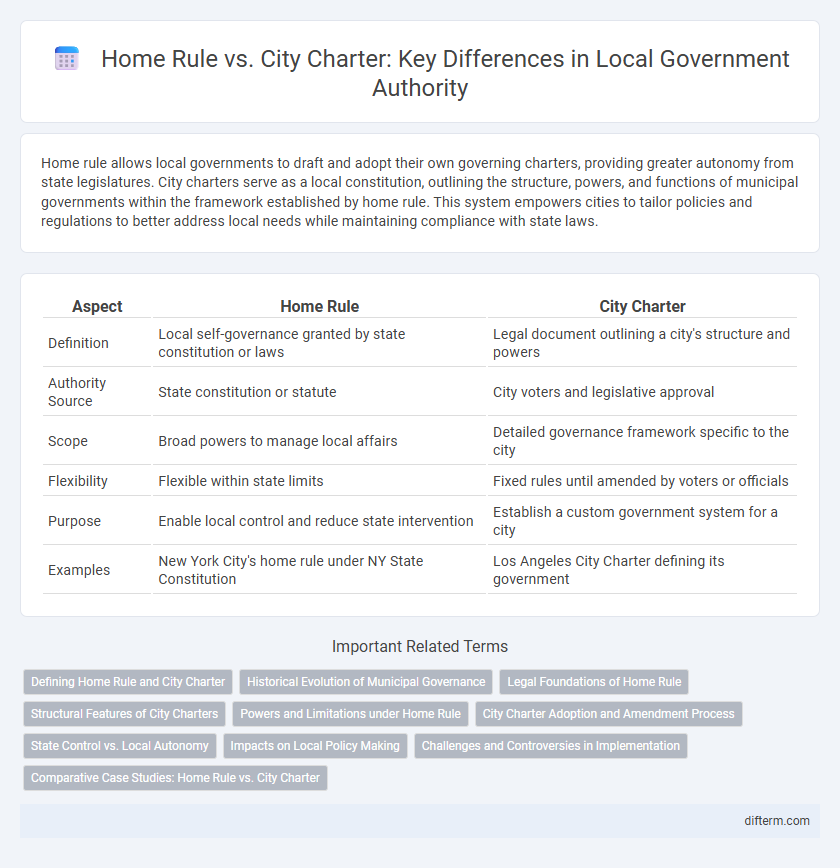Home rule allows local governments to draft and adopt their own governing charters, providing greater autonomy from state legislatures. City charters serve as a local constitution, outlining the structure, powers, and functions of municipal governments within the framework established by home rule. This system empowers cities to tailor policies and regulations to better address local needs while maintaining compliance with state laws.
Table of Comparison
| Aspect | Home Rule | City Charter |
|---|---|---|
| Definition | Local self-governance granted by state constitution or laws | Legal document outlining a city's structure and powers |
| Authority Source | State constitution or statute | City voters and legislative approval |
| Scope | Broad powers to manage local affairs | Detailed governance framework specific to the city |
| Flexibility | Flexible within state limits | Fixed rules until amended by voters or officials |
| Purpose | Enable local control and reduce state intervention | Establish a custom government system for a city |
| Examples | New York City's home rule under NY State Constitution | Los Angeles City Charter defining its government |
Defining Home Rule and City Charter
Home rule refers to the authority granted by a state constitution or legislature that allows local governments to self-govern and manage their own affairs without direct state interference. A city charter serves as a legal document or constitution specifically outlining the organization, powers, and functions of a municipal government under home rule provisions. These charters provide the framework for municipal governance, enabling cities to enact ordinances and policies tailored to local needs within the scope of state law.
Historical Evolution of Municipal Governance
Home rule grants municipalities the authority to govern themselves independently from state legislatures, evolving as a response to the limitations of rigid state control in the 19th century. City charters, foundational documents that define the organization, powers, and functions of city governments, historically emerged to formalize local governance structures and adapt to urban growth. This evolution reflects a broader trend toward decentralization and localized decision-making in municipal governance, empowering cities to address community-specific needs more effectively.
Legal Foundations of Home Rule
Home rule derives its legal foundation from state constitutions and statutes that grant local governments authority to govern themselves without state interference. City charters function as local constitutions, outlining the structure, powers, and functions of municipal governments within the framework established by home rule provisions. The balance between home rule and state control is shaped by judicial interpretations of these legal documents, influencing the extent of municipal autonomy.
Structural Features of City Charters
City charters establish the structural framework of municipal governments, outlining the distribution of powers, organizational hierarchy, and administrative procedures unique to each city. Unlike home rule, which broadly grants local autonomy, city charters specify elected officials' roles, legislative authority, and mechanisms for public accountability tailored to the community's needs. These legal documents enable cities to adapt governance structures efficiently, fostering responsive and localized policy-making within the confines of state constitutions.
Powers and Limitations under Home Rule
Home Rule grants municipalities broad authority to govern local affairs, allowing city governments to adopt ordinances, manage budgets, and regulate land use without direct state approval. However, powers under Home Rule remain subject to state constitutions and statutes, which can impose limitations, particularly in areas affecting statewide interests like taxation and public safety. This balance ensures local autonomy while preserving state oversight to prevent conflicts between municipal policies and state laws.
City Charter Adoption and Amendment Process
City charter adoption involves a community drafting and approving a governing document that outlines the structure, powers, and functions of municipal government, while home rule grants cities the constitutional authority to govern themselves independently of state legislature. The charter amendment process typically requires proposal by either a citizen initiative, city council action, or charter commission, followed by voter approval in a local referendum. These procedures ensure that municipal governance reflects local preferences and adapts to evolving community needs within the bounds of state law.
State Control vs. Local Autonomy
Home rule grants municipalities greater local autonomy by allowing cities to draft their own charters and govern without direct state interference, promoting customized policies that address specific community needs. City charters serve as the foundational legal documents outlining municipal powers and organizational structure, but the extent of state control varies depending on whether the state permits home rule or imposes strict statutory limitations. States exercising strong oversight often limit local self-governance, maintaining authority over budget, ordinances, and administrative decisions, thereby reducing city independence.
Impacts on Local Policy Making
Home rule grants local governments autonomy to enact policies tailored to community needs without state interference, enhancing responsiveness and innovation in local governance. City charters serve as foundational documents that define governmental structure and powers, but may limit flexibility if overly prescriptive or state-imposed. Variability in home rule authority directly influences the scope of policy decisions related to zoning, public safety, and taxation, affecting efficiency and resident engagement.
Challenges and Controversies in Implementation
Home rule often faces challenges related to the extent of local autonomy versus state control, causing legal disputes over preemption laws and regulatory authority. City charters can create controversies when governance structures or provisions limit flexibility in addressing local needs or when charter amendments face political resistance. Both frameworks encounter difficulties in balancing accountability, fiscal constraints, and stakeholder interests, complicating effective implementation.
Comparative Case Studies: Home Rule vs. City Charter
Comparative case studies of home rule and city charters reveal significant differences in local autonomy and governance structures. Home rule grants municipalities broader self-governing powers without state legislative interference, whereas city charters function as local constitutions that define specific government frameworks within state limitations. Examples from states like Texas and Michigan illustrate how home rule cities can enact ordinances independently, while charter cities must adhere to predefined regulations established in their charters.
home rule vs city charter Infographic

 difterm.com
difterm.com